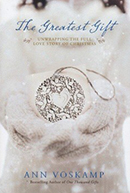
Author Ann Voskamp takes radical steps to recover the true story of Christmas. – Photo credit: Jono + Laynie (http://bit.ly/1bUjn5F)
When Ann Voskamp penned “One Thousand Gifts: Dare to Live Fully Right Where You Are”, no one predicted the book, would sit on the “New York Times” bestseller list for more than 60 weeks. Since then, Voskamp, a former greeting card writer, has continued to develop a cult following online with her homespun wisdom and poetic prose. No one can turn a phrase quite like Ann.
But now, Voskamp has shifted her attention to Christmas. Her newest book, “The Greatest Gift: Unwrapping the Full Love Story of Christmas,” was an instant bestseller and intends to wrestle the true story of Christmas from the clutches of commercialism and consumerism. Voskamp is so committed to her message that the farmer’s wife and mother of six hung her Christmas tree upside down this year. Here, we discuss how she wants to help people discover a different Christmas story and why she decided to turn that iconic Christmas symbol upside down in her home.
JM: Ann, Christian families want Jesus to be the greatest gift, but our good intentions often get crowded out by the commercial noise of December. How has your family navigated this?
AV: What Christian families want at Christmas can definitely be drowned out by the noise of December. Our family gets it, and we’ve wrestled hard with it. How did Christmas become something that we could return on Boxing Day–when Christ came to be with us? How did Christmas get handcuffed by chains of big box stores–when the Christ-child came small and subversively and for freedom? How did Christmas get to be more about cheap stuff than a lavish Savior? What makes us scared to do Christmas counter-culture—when it’s about God upending everything?
For us, we’ve purposed to have a “simplified, sane and sacred Christmas.” Simplified isn’t about circumstances–but about focus. How do we focus simply on Christ?
JM: That sounds great but what does it look like on the ground?
AV: First off, we’ve hung an upside down Christmas tree. Because we want to have an upside down Christmas. Yep, an upside down Christmas Tree. We’re hanging the holiday upside down this year so real love falls out of our Christmas. So no one gets hanged by debt. Because we’re giving the whole Christmas season to Jesus and His upside down Kingdom, not just some tossed crusty edge of of it. Because we can feel it—how we’re done with the malls and missing Jesus.
We are done with busy Christmases and brushing past Christ. We are done with over-stuffed Christmases, and we are desperate to give the gift of being overcome by Christ. You can get tired enough that you’re ready for a Christmas revolution. So for our family — we hung the Christmas tree upside down to be this visual that we want a Christmas revolution, a Christ-centered Christmas–a counter-culture, upside down Christmas.
If we’ve really welcomed Christ into our lives – it means our lives are evidence that we’ve welcomed the strangers and the neglected and the outcasts and the family across the street and the elderly couple around the corner.
Every one of the 25 readings in “The Greatest Gift”—a book that helps you “Stay in the Story” as it tells the full love story of Christmas, a book that is about a Christmas revolution that simply celebrates Christ–each day’s reading offers one ridiculously simple way to serve in a small way, just right where you are, for every day of December. Because it’s always greater to give than to receive, so in the wonder of giving—that is one way we receive the greatest gift.
JM: During the holidays, what have you found to be the temptation that woos you away from the story that is true?
AV: Well, for me, personally, there are two holiday tempters: comparison and expectations.
Comparisons… What the neighbors are doing at Christmas, how the family down the street celebrates, Pinterest, magazines–everywhere you look, you don’t feel like Martha Stewart and every “Better Homes and Garden” magazine can seem to scream: Better homes than who? Better homes than mine. It’s the measuring sticks of comparisons–the measuring sticks that woo me away from the full love story of Christmas. I can find myself walking around with a measuring stick everywhere, trying to figure out if our holidays are measuring up, which ends up tearing the holiday down.
I try to preach Gospel to myself: Comparison is a thug that robs your joy. And it’s even more than that–Comparison makes you a thug who beats down somebody–or your soul.
JM: And what about the second one? What are your expectations for the season?
MF: My expectations are that our Christmas will look like this: The kids will be perfect and we will live this beautiful Christmas card Christmas. But then the dog pukes on the back step and my husband forgets the one ingredient for the cookies I need to make for the cookie exchange and the boys just keep bickering with each other, and the realization comes that expectations can kill relationships. They can kill my relationship with God, with my family. Expectations can kill holidays.
And if expectations kill holidays–then I fight that expectation tempter with constant gratitude. Daily writing down blessings, gifts. Daily beginning the holidays, every day, with not my to-do list, but my gratitude list. Keeping that gratitude list out and present. I wonder if this is why Thanksgiving comes before Christmas, that we begin the holidays with gratitude. We must begin everything with thanksgiving, gratitude. The beginning of joy is always thanksgiving.
JM: What is the Jesse Tree, and what does it have to do with Christmas?
AV: Well, “The Greatest Gift” has 25 readings, one for each day of the month of December, and each of the Scripture readings and accompanying devotionals, outline “The Jesse Tree”–this tracing of Jesus’ family tree. The name, “Jesse Tree” is taken from Isaiah 11:1, in which Jesus is announced as a shoot of grace coming up from the cut down stump of Jesse’s tree–Jesse being David’s father.
Because when you open the pages of Scripture to read of Christ’s coming, of this first advent, before you ever read of the birth of Jesus, you always have the genealogy of Jesus. It’s the way Christmas unwraps really: Before you have a Christmas tree, you have Christ’s family tree. If you don’t come to Christmas through Christ’s family tree and you come into the Christmas story just at the Christmas tree, and it’s hard to fully understand the miracle and meaning and context of Christ’s coming.
Without the genealogy of Christ, the limbs of his past, the branches of his family, the love story of his heart that has been coming for us since before the beginning, how does Christmas and its tree stand? Its roots would be sheared.
So as you read each of the 25 devotional readings, each highlighting a Scripture passage from the Old Testament and Jesus’ family line, from Genesis to God-in-the-flesh, there is an accompanying ornament to hang that day, so that you have a tree telling the story of Jesus’ coming right from the beginning, a grace tree, a gospel tree — the full love story of Christmas.
JM: Who is the most surprising character in Jesus’ lineage?
AV: The coming of Christ was right through families of messed-up monarchs and battling brothers, through affairs and adultery and more than a feud or two, through skeletons in closets and cheaters at tables. At the time of Mary and Joseph, that men were in genealogies and women were invisible. But for Jesus, women had names and stories and lives that mattered.
The family tree of Christ startlingly notes not one woman, but four. Four broken women—Ruth and Rahab, Bathsheba and Tamar–women who felt like outsiders, like has-beens, like never-beens. Women who were weary of being taken advantage of, of being unnoticed and uncherished and unappreciated; women who didn’t fit in, who didn’t know how to keep going, what to believe, where to g. Women who had thought about giving up. And Jesus claims exactly these who are wandering and wondering and wounded and worn out as His. He grafts you into his line and his story and his heart, and he gives you His name, His lineage, His righteousness. He graces you with plain grace.
I’m riveted by Rahab.
Rahab has had a line waiting out her back door. Men lined up at her inn, wanting a place to lie down and get a piece of her. In a town with no Sabbaths, no lines of God’s word ever read, no prophets with a message of a coming visitation from heaven, she’s one woman alone with the grime of too many nights on her hands, the weight of too many wounds on her heart. She’s a woman who looks up in her godless mess and sees the tenderness of God.
In a place of faithlessness and doubtfulness and godlessness, God gives God. The God who can reveal Himself wherever, whenever, to whomever; the God who is never limited by lack or restricted to the expected; the God who is no respecter of persons but the relentless rescuer of prodigals; the God who gives the gift of faith in the places you’d most doubt. That is always the secret to the abundant life: to believe that God is where you doubt he can be.
Rahab, in a godless place with a godless past, believes fully—and so lives fully. She steps out not in competence but in faith. She serves not her admirers but her adversaries. She saves the greatest gift for her family—a place of grace. She risks to live.
Rahab, the scarlet woman, flings a scarlet cord out her window—that one thread everything’s hanging on. And that scarlet cord is her identity—that scarlet line running from the animal sacrifice covering Adam and Eve’s nakedness in the Garden of Eden to the crimson markings of blood on the doorframes of the first Passover to the willing drops of blood in the garden of Gethsemane—and Rahab is delivered by that singular scarlet cord and tied into the Jewish family. And God makes the former woman of the night into a woman of the court—a princess and a wife of a Jewish prince, Salmon. Their family line is furthered with a son—a son who would be the kinsman-redeemer of another foreign woman: a son named Boaz. The mother of Boaz is this Rahab; the mother-in-law of Ruth is this Rahab; the great-grandmother of the great king David is this Rahab.
The great-grandmother of Christ many times removed— former prostitute, pagan, and profligate—Rahab finds herself the only other woman besides Sarah to be noted in the heroes’ hall of faith. Rahab, right there beside the fathers of the faith—Abraham, Jacob, Isaac, Moses, and Noah: “By faith the harlot Rahab perished not with them that believed not, when she had received the spies with peace” (Hebrews 11:31, KJV).
By faith, Rahab stands as “a blessed example both of the sovereignty of God’s grace and of its power,” writes the puritan theologian John Owen. “Nobody, no sin, should lead to despair when the cure of God’s sovereign, almighty grace is engaged.”
Nobody and no situation—no sin, no mess, no decision—meets the diagnosis of despair. Because there’s God’s cure of amazing grace.
That scarlet cord Rahab threw out that window? In Hebrew, that cord is a tikvah. The same word in Hebrew that means “hope.” You think about that as you tie string around Christmas gifts. How there’s only a singular cord in this knotted mess of a world worth reaching for. It’s dangling right there from our impossible tangle, and it’s the one hope you need to reach for this advent. That scarlet lifeline of Christ–the “greatest gift.”






